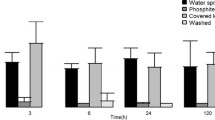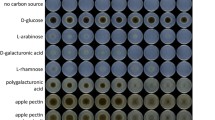Abstract
A new type of plant-derived signal molecules that activate extracellular pectate lyase activity in phytopathogenic bacterium Pectobacterium atrosepticum SCRI1043 was revealed. These compounds were characterized and partially purified by means of several approaches including RT-PCR analysis, luminescence bioassay and HPLC fractionation. They were smaller than 1 kDa, thermoresistant, nonproteinaceous, hydrophilic, and slightly negatively charged molecules. Using gene expression analysis and bacterial biosensor assay the mode of activity of revealed compounds was studied. The possibility of their action through quorum sensing- and KdgR-mediated pathways was analyzed.







Similar content being viewed by others
References
Barnard AML, Salmond GPC (2007) Quorum sensing in Erwinia species. Anal Bioanal Chem 387:415–423
Barras F, van Gijsegem F, Chatterjee AK (1994) Extracellular enzymes and pathogenesis of soft-rot Erwinia. Annu Rev Phytopathol 32:201–234
Blot N, Berrier C, Hugouvieux-Cotte-Pattat N, Ghazi A, Condemine G (2002) The oligogalacturonate-specific porin KdgM of Erwinia chrysanthemi belongs to a new porin family. J Biol Chem 277:7936–7944
Bourson C, Favey S, Reverchon S, Robert-Baudouy J (1993) Regulation of the expression of a pelA : uidA fusion in Erwinia chrysantemi and demonstration of the synergistic action of plant extract with polygalacturonate on pectate lyase synthesis. J Gen Microbiol 139:1–9
Brencic A, Winans S (2005) Detection of and response to signals involved in host-microbe interactions by plant-associated bacteria. Microbiol Mol Biol Rev 69:155–194
Charkowski A, Blanco C, Condemine G et al (2012) The role of secretion systems and small molecules in soft-rot Enterobacteriaceae pathogenicity. Annu Rev Phytopathol 50:425–449
Chatterjee A, Cui Y, Liu Y, Dumenyo CK, Chatterjee AK (1995) Inactivation of rsmA leads to overproduction of extracellular pectinases, cellulases, and proteases in Erwinia carotovora subsp. carotovora in the absence of the starvation/cell density-sensing signal, N-(3-oxohexanoyl)-l-homoserine lactone. Appl Environ Microbiol 61:1959–1967
Crepin A, Beury-Cirou A, Barbey C et al (2012) N-acyl homoserine lactones in diverse Pectobacterium and Dickeya plant pathogens: diversity, abundance, and involvement in virulence. Sensors 12:3484–3497
Fray RG (2002) Altering plant-microbe interaction through artificially manipulating bacterial quorum sensing. Ann Bot 89:245–253
Hassan S, Hugouvieux-Cotte-Pattat N (2011) Identification of two feruloyl esterases in Dickeya dadantii 3937 and induction of the major feruloyl esterase and of pectate lyases by ferulic acid. J Bacteriol 193:963–970
Hugouvieux-Cotte-Pattat N, Robert-Baudouy J (1989) Isolation of Erwinia chrysantemi mutants altered in pectinolytic enzyme production. Mol Microbiol 3:1587–1597
Hugouvieux-Cotte-Pattat N, Domingnez H, Robert-Baudouy J (1992) Environmental conditions affect transcription of the pectinase genes of Erwinia chrysanthemi 3937. J Bacteriol 174:7807–7818
Hugouvieux-Cotte-Pattat N, Condemine G, Nasser W, Reverchon S (1996) Regulation of pectinolysis in Erwinia chrysanthemi. Ann Rev Microbiol 50:213–257
Kelemu S, Collmer A (1993) Erwinia chrysanthemi EC16 produces a second set of plant-inducible pectate lyase isozymes. Appl Environ Microbiol 59:1756–1761
Lautier T, Blot N, Muskhelishvili G, Nasser W (2007) Integration of two essential virulence modulating signals at the Erwinia chrysanthemi pel gene promoters: a role for Fis in the growth-phase regulation. Mol Microbiol 66:1491–1506
Lindsay A, Ahmer BM (2005) Effect of sdiA on biosensor of N-acyl homoserine lactones. J Bacteriol 187:5054–5058
Liu H, Coulthurst SJ, Pritchard L, Hedley PE, Ravensdale M, Humphris S, Burr T, Takle G, Brugberg M-B, Birch PRJ, Salmond GPC, Toth IK (2008) Quorum sensing coordinates brute force and stealth modes of unfection in the plant pathogen Pectobacterium atrosepticum. PLoS Pathog 4:1–11
Mae A, Montesano M, Koiv V, Palva ET (2001) Transgenic plants producing the bacterial pheromone N-acylhomoserine lactone exhibit enhanced resistance to the bacterial phyto-pathogen Erwinia carotovora. Mol Plant Microbe Interact 14:1035–1042
Mattinen L, Nissinen R, Riipi T, Kalkkinen N, Pirhonen M (2007) Host extract induces changes in the secretome of the plant pathogenic bacterium Pectobacterium atrosepticum. Proteomics 7:3527–3537
Miller JH (1972) Experiments in molecular genetics. Cold Spring Harbor Laboratory, Cold Spring Harbor
Moran F, Nasuno S, Starr MP (1968) Extracellular and intracellular polygalacturonic acid transeliminase of Erwinia carotovora. Arch Biochem Biophys 123:293–306
Nasser W, Reverchon S, Condemine G, Robert-Baudouy J (1994) Specific interactions of Erwinia chrysanthemi KdgR repressor with different operators of genes involved in pectinolysis. J Mol Biol 236:427–440
Perombelon MCM (2002) Potato diseases caused by soft rot erwinias: an overview of pathogenesis. Plant Pathol 51:1–12
Pirhonen M, Saarilahti H, Karlsson M-B, Palva T (1991) Identification of pathogenicity determinants of Erwinia carotovora subsp. carotovora by transposon mutagenesis. Mol Plant Microbe Interact 4:276–283
Reverchon S, Expert D, Robert-Baudouy J, Nasser W (1997) The cyclic AMP receptor protein is the main activator of pectinolysis genes in Erwinia chrysanthemi. J Bacteriol 179:3500–3508
Roy C, Visser J, Shevchik V, Hugouvieux-Cotte-Pattat N, Robert-Baudouy J, Benen J (1999) Modes of action of five different endopectate lyases from Erwinia chrysanthemi 3937. J Bacteriol 181:3705–3709
Savli H, Karadenizli A, Kolayli F, Gundes S, Ozbek U, Vahaboglu H (2003) Expression stability of six housekeeping genes: a proposal for resistance gene quantification studies of Pseudomonas aeruginosa by real-time quantitative RT-PCR. J Med Microbiol 52:403–408
Sepulchre JA, Reverchon S, Nasser W (2007) Modeling the onset of virulence in a pectinolytic bacterium. Theor Biol 244:239–257
Teplitski M, Robinson JB, Bauer WD (2000) Plants secrete substances that mimic bacterial N-acyl homoserine lactone signal activities and affect population density-dependent behaviors in associated bacteria. Mol Plant Microbe Interact 13:637–648
Wei Z-M, Sneath BJ, Beer SV (1992) Expression of Erwinia amylovora hrp genes in response to environmental stimuli. J Bacteriol 174:1875–1882
Whitehead NA, Byers JT, Commander P, Corbett MJ, Coulthurst SJ, Everson L, Harris AKP, Pemberton CL, Simpson NJL, Slater H, Smith DS, Welch M, Williamson N, Salmond GPS (2002) The regulation of virulence in phytopathogenic Erwinia species: quorum sensing, antibiotics and ecological consideration. Antonie Van Leeuwenhoek 81:223–231
Acknowledgments
This work was supported in part by the Russian Foundation for Basic Research, research project No. 12-04-31059-MOL A and by a grant from the programme “Leading Scientific Schools” No. NSH-825.2012.4 (Supervisor A.N. Grechkin).
Author information
Authors and Affiliations
Corresponding author
Rights and permissions
About this article
Cite this article
Tarasova, N., Gorshkov, V., Petrova, O. et al. Potato signal molecules that activate pectate lyase synthesis in Pectobacterium atrosepticum SCRI1043. World J Microbiol Biotechnol 29, 1189–1196 (2013). https://doi.org/10.1007/s11274-013-1281-9
Received:
Accepted:
Published:
Issue Date:
DOI: https://doi.org/10.1007/s11274-013-1281-9




